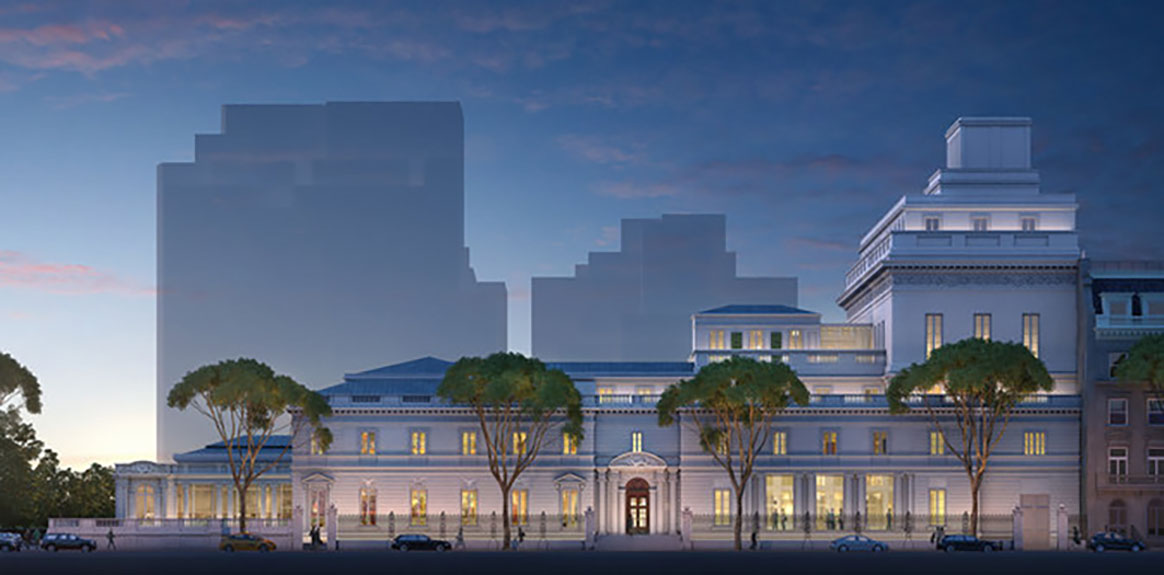FRIENDS of the Upper East Side Historic Districts has carefully reviewed the proposal presented for expansion of the Frick Collection to our Board Members on July 17, 2014. The Henry Clay Frick House is a National Historic Landmark, an individually-designated New York City landmark, and located within the Upper East Side Historic District. Our comments encompass not only issues of appropriateness that may eventually be the concern of the Landmarks Preservation Commission, but also question the management of space throughout the site and offer alternatives to this scheme.
A JEWEL BOX
The Frick is a extraordinary building on the Upper East Side, and indeed, the city. This richly-appointed mansion is as much a masterpiece as any of the objects inside. The renderings of the proposal institutionalize the residence — counter to the very mission of the museum: “to offer a singular and memorable experience for the visiting public, providing an engaging view of life in the Gilded Age.”
THE BULK
In an effort to avoid adding to the building piece-meal, the project team has established two parameters: continue the street wall at East 70th Street and continue the massing of the Reference Library towards the south. The result is enormous, and ultimately more square footage than is required based upon the proposed floor plans.
And yet, at the same time the net increase in gallery or exhibition space would be a mere 3,600 square feet. Thus, a large proportion of the square footage of the new building would be built almost entirely for “backstage” functions. Although this project is meant to further the museum’s mission, we were left to wonder how so much ancillary space could achieve this goal.
Furthermore, the Reference Library extension creates an unusual condition for the mid-block – one with the scale of an apartment building that cuts through the doughnut of the rear yard in an unprecedented manner. Viewed from Fifth Avenue or Central Park, the new addition will thoroughly overwhelm the original building, as well as one’s understanding of both its history and design. Without renderings of the new building from Madison Avenue, one can only assume how disruptive such a mass is to the entire block.
THE GREEN SPACE
The project team rightly mentioned the “pavilion” aspect of the mansion, free-standing on its Fifth Avenue garden. The fact that it floats in a garden on both the west and southern edges reinforces this identity. The National Historic Landmark Nomination Form for The Frick Collection and the Frick Art Reference Library Building states, “The setting of the [Frick] enhanced its monumentality, giving the structure an elegant distance from the street and adjacent houses.” (p. 18)
Likewise, the Henry Clay Frick House and the Andrew Carnegie House were “the only two of the Fifth Avenue residences that incorporated major gardens and landscaping, a conspicuously expensive use of Manhattan land that in most cases merely translated into large footprints for houses.”(National Historic Landmark Nomination Form: “The Frick Collection and the Frick Art Reference Library Building,” p. 18). Thus the green space flanking the museum is a significant, historic condition that distinguishes this former residence from its urban surroundings and is essential to its preservation.
THE GARDEN
The Russell Page Garden at the Frick Collection – the only design by this famed landscape architect in New York City – should be preserved as a great addition to the museum and an amenity to the neighborhood. Although it is inaccessible to the public, it is a delight to see and experience from the street. Like the White House lawn, it can be fully-appreciated, in all its majesty, without stepping foot inside the gate.
The garden is a tranquil respite from the cityscape, existing in harmony with the museum, the street, and the Upper East Side. Over its 37 years, it has become a historically-significant and integral part of the Frick Collection, one that deserves preservation.
THE EVOLUTION OF A LANDMARK
Often new information or evaluation emerges over time, enhancing our understanding of a structure’s history and value. For example, although the John Russell Pope scheme is not original to the Henry Clay Frick residence, it is an integral part of the landmark site. “[The Frick’s] transition from a private house museum to a publicly accessible institution whose core mission was retention of the character established by Frick, required an expansion program so expertly conceived by John Russell Pope, that the earlier and later portions read as a seamless whole.” (National Historic Landmark Nomination Form: “The Frick Collection and the Frick Art Reference Library Building,” p. 4)
The argument that the Russell Page Garden should be denied preservation because it was installed after the original Carrere & Hastings design, and subsequent Pope reconfiguration, is an insufficient rationalization for demolition. In the nearly half-century since the creation of the Landmarks Preservation Commission, many buildings in New York City have undergone historically-significant alterations and accretions that themselves have been deemed worthy of protection — and even celebration. In fact, there are many instances where the later changes have become even more important, extending the period of significance beyond the original.
The Russell Page Garden is by now a venerable addition, and as it was completed in 1977 it is old enough to be a landmark on its own. Additionally, the Landmarks Preservation Commission’s designation amendment makes it clear that plans for the one-story addition and the garden were reviewed and awarded a Certificate of Appropriateness.
ALTERNATIVES
The Upper East Side is home to an internationally-renowned group of art institutions – the Magnificent Mile – all of which have seen growth of their collections, as well as attendance. Responding to this, some institutions have thoughtfully reassessed their existing interiors, finding efficiencies and new space for both public use and administrative needs. Since this project includes rearranging much of the existing interior spaces, that reallocation process is worth a second look whereby the museum’s goals could be achieved without a large-scale new addition.
Meanwhile, many other institutions along Museum Mile have expanded into other buildings. Fortunately, the Frick has an option right next door which should satisfy many space requirements. The ground-floor, two-story condominium unit located at 11 East 70th Street (contiguous to the garden and presently housing the Berry-Hill Gallery) could be purchased. The museum could excavate the garden (rebuilding it to match the present design) and connect to the Berry-Hill space. Such a scheme would increase the museum’s size by 10,000 square feet, including the neighboring gallery and excavated lower level below the restored garden.
CONCLUSION
In sum, FRIENDS of the Upper East Side Historic Districts is opposed to this project as presented. The Frick Collection is a unique mansion in an urban setting, and any alterations should be respectful of its history as a residence. The proposed project is far too large and ungainly, overwhelming the museum, as well as the streetscape. The green space flanking the Frick contributes to the sense that it is an important free-standing structure. The Russell Page Garden is significant in its own right, and is further protected as part of the landmark site. Finally, there are many other options for expansion that have yet to be pursued.
FRIENDS welcomes continued discussion with the Frick. We look forward to seeing a revised proposal, taking our comments into account.
To learn more about this issue, please read the following articles:
- The Case Against A Mammoth Frick Collection Addition by Michael Kimmelman. The New York Times, July 30, 2014.
- Here’s What’s Missing In The Debate Over The Frick Collection’s Proposed Expansion by Charles A. Birnbaum. Huffington Post, June 30, 2014.
- Save the Frick Collection by David Masello. The New York Times, June 12, 2014.
And visit the following web sites:

Frick expansion plan

